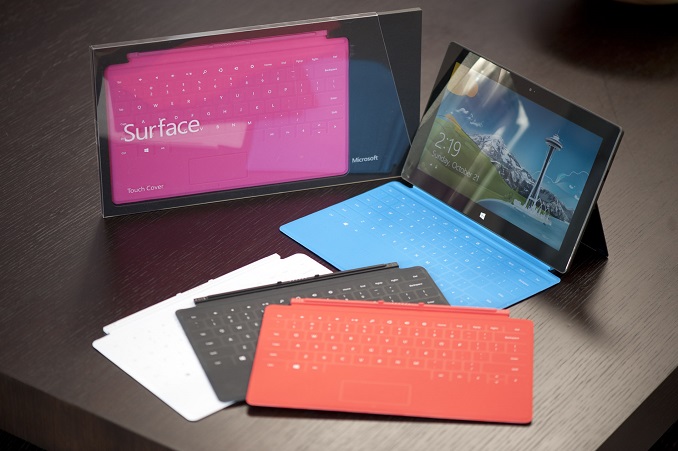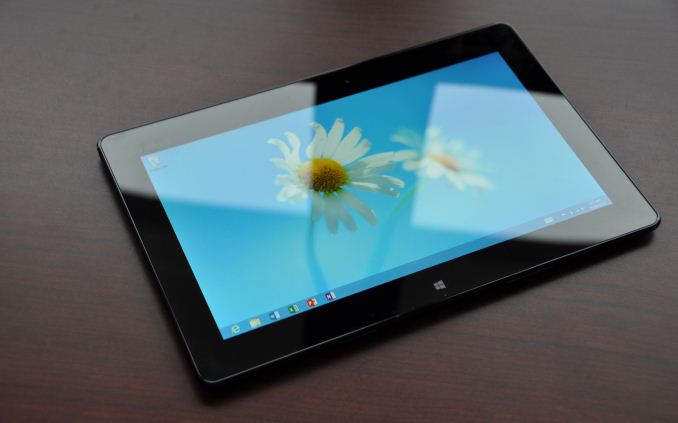Windows RT Will Not Get Windows 10 Update
by Brett Howse on January 22, 2015 5:30 PM EST- Posted in
- Operating Systems
- Windows
- Microsoft
- Windows RT

Microsoft has confirmed today that Windows RT will not be upgraded to Windows 10. The official statement from the company is that Surface Pro will be updated to Windows 10, and “we are working on an update for Surface (RT and Surface 2), which will have some of the functionality of Windows 10.” For anyone who purchased either the Surface RT, or the Surface 2, this is a fairly poor message, especially considering the Surface 2 was still for sale not very long ago.
Windows RT was certainly a marketing failure, and arrived at the wrong time and for the wrong reasons. The initial hardware, such as the Tegra 3 powered Surface RT, was fairly underpowered, and sales were poor causing Microsoft to write down $900 million in inventory. The next generation Surface 2 was a much better performing device, but with the ARM CPU inside it was not able to run any of the traditional Windows applications. By the time Surface 2 came to market, Intel had low power Bay Trail CPUs which were competitive on power usage, and offered good performance, plus offered backwards compatibility with all of the Win32 desktop applications, leaving Microsoft as the only vendor selling Windows RT devices.
There were advantages to Windows RT of course, with little chance of malware finding its way onto the system, but the Windows Store ecosystem still lags behind iOS and Android as far as the number of tablet apps available.
It is disappointing to see support dropped so quickly, and of course harkens back to the Windows Phone 7 owners who did not get a Windows Phone 8 upgrade, but in the same vein, some work appears to be underway to bring some of the Windows 10 features to the short lived ARM version of Windows. The strangest part is that with the Hardware Abstraction Layer work already done, the amount of work to bring Windows 10 to the Surface RT and Surface 2 should be minimal, and with Windows Phone being replaced with Windows 10, universal apps will still have to be compiled for ARM chips, making the abandonment of the devices a strange notion when Windows 10 is going to be offered as a free upgrade.
Source: Paul Thurrott











41 Comments
View All Comments
Beany2013 - Thursday, January 22, 2015 - link
I wasn't expecting this, actually.I was looking at how Windows Server Core was moving along, and then looking at the interesting announcements RE ARM servers for use in hyperscale cloud stuff, and I was quite sure that the ARM code would live on in a Server Core variant.
Apparently not.
Ah well, I'm on Linux full time these days, it's of little relevance to me. Still interesting though.
DanNeely - Thursday, January 22, 2015 - link
It still could. Historically MS has maintained the ability to compile Windows to a number of CPU platforms that they never released the OS for as a way to make sure they don't inadvertently bake in a hard x86 dependency by accident. And since they need to maintain the ability to build the core of Windows on ARM for phones; I'd be surprised if they're not maintaining the rest as well.Ryan Smith - Thursday, January 22, 2015 - link
Indeed. Dropping support for a whole platform does not mean they aren't keeping it on the backburner. All of that portability work that went into WinRT and WinPhone will be alive and well, if only because they need it for WinPhone.name99 - Friday, January 23, 2015 - link
TECHNICALLY they will probably retain the ability to run Windows on ARM. But that technical ability has no BUSINESS value because no-one in their right mind (OEM or customer) will ever again trust a Windows targeting non-x86.MS has pulled this stunt how many times now? MIPS? PPC? Alpha? Itanium? Now ARM. The company obviously is not seriously interested in MAINTAINING a non-x86 presence; they pull this out every so often to get concessions from Intel, then, as soon as the concessions have been obtained, lose interest. You could have argued that RT was something different from those mid 90's experiments; but the company's behavior here shows that nothing has really changed.
The third time MS tries this, they're just going to be laughed at...
It's a shame because RT is actually a very sensible idea, IMHO. MS has a foot in Enterprise (where people want and need complexity and endless backward compatibility) and in Consumer (where simplicity and security, at the expense of backward compatibility) are more prized. Having RT as the Consumer-facing version of Windows makes a lot of sense (basically the equivalent of the iOS/OSX split). But MS was unwilling to actually provide the technical muscle to make this work, not to mention throwing in a third fscking OS, WinPhone, just to muddy the waters, rather than presenting WinPhone/RT as a single united entity.
Yeah, yeah, yeah, plenty of happy talk now about universal apps and how super-awesome Win 10 will be. But MS still has not SOLVED the fundamental problem --- this Consumer/Enterprise split that I mentioned. Talk about "no compromises" is BS. We heard this with Win8, and how well did denying reality work out there? A screwdriver is never going to be a good hammer, even if it's the greatest screwdriver in the world, and calling a screwdriver a "universal tool", designed with the needs of hammer-users in mind, doesn't change that fact.
ayejay_nz - Thursday, January 22, 2015 - link
Kill RT, kill it dead.Flunk - Thursday, January 22, 2015 - link
This is not that surprising, seeing as Microsoft already did this to Windows Phone 7 users (for significantly less reason). I feel for any WinRT users (if there are any), it's really annoying when your platform gets dumped.meacupla - Thursday, January 22, 2015 - link
Well, that was fast. I could never justify Surface or any device running WinRT for anyone, even with the reduced cost of it being bundled with office. It was just hard to explain how it was Windows, but couldn't run programs made for Windows.WinRT was very similar to having a car you could never drive on public roads, because it had square wheels.
Daniel Egger - Friday, January 23, 2015 - link
The problem is not that it couldn't run "programs made for Windows" because in fact it can (after a jailbreak). The problem is that Microsoft thought they could create a completely closed environment where no one could use just any programs they desire (free or commercial doesn't matter) without creating a separate *special* version that could be uploaded to the Windows Store so that Microsoft could make a huge profit and fuel their shitty store with applications for all platforms.They knew they couldn't just lockdown the real windows so they had to use the new platforms Windows Phone and Windows RT. For WP it was less of a problem since applications had to be created from scratch anyway. For RT it really was a cheap ploy that most of the developers saw coming.
domboy - Friday, January 23, 2015 - link
Exactly. I've run the jailbreak on my RT since day 1, and it's actually a really useful device. If Microsoft had actually released it as an open platform like x86 Windows the story might have been different... of course as Daniel mentioned, that's not what they wanted from it. So while I'm sad that Windows on ARM is going away for anything bigger than a small tablet, I'm glad that customers sent the message that they didn't want Windows to become a lock-down OS.rxzlmn - Friday, January 23, 2015 - link
I'm sorry, I don't know anything about how RT can run 'Windows' programs, but what exactly can it run? .NET only? Java? Anything? If the latter, how?